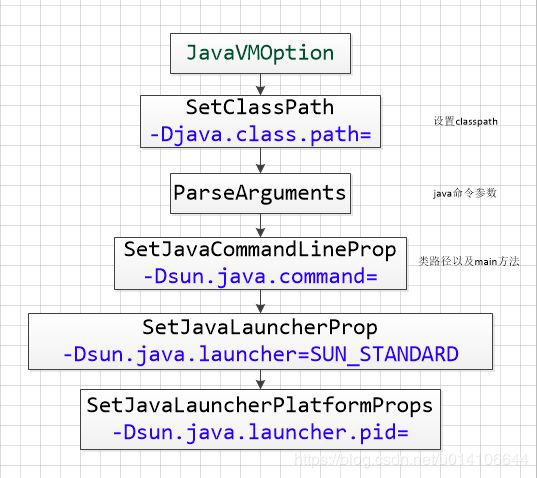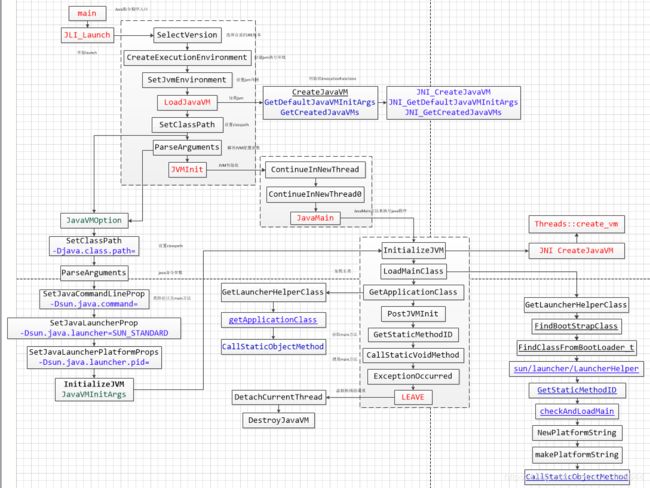JVM进阶5--JVM启动过程JavaVMOption分析
JVM启动时,需要从java命令以及操作系统读取一系列配置参数来进行JVM创建工作。
JVM参数配置由结构体JavaVMOption来定义保存
/*
* List of VM options to be specified when the VM is created.
*/
static JavaVMOption *options;
static int numOptions, maxOptions;typedef struct JavaVMOption {
char *optionString;
void *extraInfo;
} JavaVMOption;其中还有两个变量分别表示参数个数以及最大参数个数,用于当参数过多时,需要进行内存分配。由于参数不确定,因此系统初始化JavaVMOption具有一定的容量,当参数过多时,需要将JavaVMOption扩容。
参数配置解析的过程就是对于结构体JavaVMOption赋值初始化的过程
CLASSPATH环境变量
由以下源码可知,classpath变量默认读取系统环境变量“CLASSPATH”,如果该变量没有配置,则设置为.,表示当前路径。
if (IsJavaArgs()) {
/* Preprocess wrapper arguments */
TranslateApplicationArgs(jargc, jargv, &argc, &argv);
if (!AddApplicationOptions(appclassc, appclassv)) {
return(1);
}
} else {
/* Set default CLASSPATH */
cpath = getenv("CLASSPATH");
if (cpath == NULL) {
cpath = ".";
}
SetClassPath(cpath);
}使用形式-Djava.class.path=%s来设定classpath
static void
SetClassPath(const char *s)
{
char *def;
const char *orig = s;
static const char format[] = "-Djava.class.path=%s";
/*
* usually we should not get a null pointer, but there are cases where
* we might just get one, in which case we simply ignore it, and let the
* caller deal with it
*/
if (s == NULL)
return;
s = JLI_WildcardExpandClasspath(s);
if (sizeof(format) - 2 + JLI_StrLen(s) < JLI_StrLen(s))
// s is corrupted after wildcard expansion
return;
def = JLI_MemAlloc(sizeof(format)
- 2 /* strlen("%s") */
+ JLI_StrLen(s));
sprintf(def, format, s);
AddOption(def, NULL);
if (s != orig)
JLI_MemFree((char *) s);
}Java命令行参数解析
主要来解析java指令其后的参数配置,例如classpath Xmx Xms Xss等。
/* Parse command line options; if the return value of
* ParseArguments is false, the program should exit.
*/
if (!ParseArguments(&argc, &argv, &mode, &what, &ret, jrepath))
{
return(ret);
}具体的参数解析过程如下:
/*
* Parses command line arguments. Returns JNI_FALSE if launcher
* should exit without starting vm, returns JNI_TRUE if vm needs
* to be started to process given options. *pret (the launcher
* process return value) is set to 0 for a normal exit.
*/
static jboolean
ParseArguments(int *pargc, char ***pargv,
int *pmode, char **pwhat,
int *pret, const char *jrepath)
{
int argc = *pargc;
char **argv = *pargv;
int mode = LM_UNKNOWN;
char *arg;
*pret = 0;
while ((arg = *argv) != 0 && *arg == '-') {
argv++; --argc;
if (JLI_StrCmp(arg, "-classpath") == 0 || JLI_StrCmp(arg, "-cp") == 0) {
ARG_CHECK (argc, ARG_ERROR1, arg);
SetClassPath(*argv);
mode = LM_CLASS;
argv++; --argc;
} else if (JLI_StrCmp(arg, "-jar") == 0) {
ARG_CHECK (argc, ARG_ERROR2, arg);
mode = LM_JAR;
} else if (JLI_StrCmp(arg, "-help") == 0 ||
JLI_StrCmp(arg, "-h") == 0 ||
JLI_StrCmp(arg, "-?") == 0) {
printUsage = JNI_TRUE;
return JNI_TRUE;
} else if (JLI_StrCmp(arg, "-version") == 0) {
printVersion = JNI_TRUE;
return JNI_TRUE;
} else if (JLI_StrCmp(arg, "-showversion") == 0) {
showVersion = JNI_TRUE;
} else if (JLI_StrCmp(arg, "-X") == 0) {
printXUsage = JNI_TRUE;
return JNI_TRUE;
/*
* The following case checks for -XshowSettings OR -XshowSetting:SUBOPT.
* In the latter case, any SUBOPT value not recognized will default to "all"
*/
} else if (JLI_StrCmp(arg, "-XshowSettings") == 0 ||
JLI_StrCCmp(arg, "-XshowSettings:") == 0) {
showSettings = arg;
} else if (JLI_StrCmp(arg, "-Xdiag") == 0) {
AddOption("-Dsun.java.launcher.diag=true", NULL);
/*
* The following case provide backward compatibility with old-style
* command line options.
*/
} else if (JLI_StrCmp(arg, "-fullversion") == 0) {
JLI_ReportMessage("%s full version \"%s\"", _launcher_name, GetFullVersion());
return JNI_FALSE;
} else if (JLI_StrCmp(arg, "-verbosegc") == 0) {
AddOption("-verbose:gc", NULL);
} else if (JLI_StrCmp(arg, "-t") == 0) {
AddOption("-Xt", NULL);
} else if (JLI_StrCmp(arg, "-tm") == 0) {
AddOption("-Xtm", NULL);
} else if (JLI_StrCmp(arg, "-debug") == 0) {
AddOption("-Xdebug", NULL);
} else if (JLI_StrCmp(arg, "-noclassgc") == 0) {
AddOption("-Xnoclassgc", NULL);
} else if (JLI_StrCmp(arg, "-Xfuture") == 0) {
AddOption("-Xverify:all", NULL);
} else if (JLI_StrCmp(arg, "-verify") == 0) {
AddOption("-Xverify:all", NULL);
} else if (JLI_StrCmp(arg, "-verifyremote") == 0) {
AddOption("-Xverify:remote", NULL);
} else if (JLI_StrCmp(arg, "-noverify") == 0) {
AddOption("-Xverify:none", NULL);
} else if (JLI_StrCCmp(arg, "-prof") == 0) {
char *p = arg + 5;
char *tmp = JLI_MemAlloc(JLI_StrLen(arg) + 50);
if (*p) {
sprintf(tmp, "-Xrunhprof:cpu=old,file=%s", p + 1);
} else {
sprintf(tmp, "-Xrunhprof:cpu=old,file=java.prof");
}
AddOption(tmp, NULL);
} else if (JLI_StrCCmp(arg, "-ss") == 0 ||
JLI_StrCCmp(arg, "-oss") == 0 ||
JLI_StrCCmp(arg, "-ms") == 0 ||
JLI_StrCCmp(arg, "-mx") == 0) {
char *tmp = JLI_MemAlloc(JLI_StrLen(arg) + 6);
sprintf(tmp, "-X%s", arg + 1); /* skip '-' */
AddOption(tmp, NULL);
} else if (JLI_StrCmp(arg, "-checksource") == 0 ||
JLI_StrCmp(arg, "-cs") == 0 ||
JLI_StrCmp(arg, "-noasyncgc") == 0) {
/* No longer supported */
JLI_ReportErrorMessage(ARG_WARN, arg);
} else if (JLI_StrCCmp(arg, "-version:") == 0 ||
JLI_StrCmp(arg, "-no-jre-restrict-search") == 0 ||
JLI_StrCmp(arg, "-jre-restrict-search") == 0 ||
JLI_StrCCmp(arg, "-splash:") == 0) {
; /* Ignore machine independent options already handled */
} else if (ProcessPlatformOption(arg)) {
; /* Processing of platform dependent options */
} else if (RemovableOption(arg)) {
; /* Do not pass option to vm. */
} else {
AddOption(arg, NULL);
}
}
if (--argc >= 0) {
*pwhat = *argv++;
}
if (*pwhat == NULL) {
*pret = 1;
} else if (mode == LM_UNKNOWN) {
/* default to LM_CLASS if -jar and -cp option are
* not specified */
mode = LM_CLASS;
}
if (argc >= 0) {
*pargc = argc;
*pargv = argv;
}
*pmode = mode;
return JNI_TRUE;
}基本过程就是接收java指令传递的参数,进行判断处理,然后利用AddOption方法写入到JavaVMOption中。
常见的堆大小以及线程栈大小配置参数
Xss每个线程的堆栈大小 Xoss本地方法栈的大小 Xms堆区初始值 Xmx堆区最大值
} else if (JLI_StrCCmp(arg, "-ss") == 0 ||
JLI_StrCCmp(arg, "-oss") == 0 ||
JLI_StrCCmp(arg, "-ms") == 0 ||
JLI_StrCCmp(arg, "-mx") == 0) {
char *tmp = JLI_MemAlloc(JLI_StrLen(arg) + 6);
sprintf(tmp, "-X%s", arg + 1); /* skip '-' */
AddOption(tmp, NULL);void
AddOption(char *str, void *info)
{
/*
* Expand options array if needed to accommodate at least one more
* VM option.
*/
if (numOptions >= maxOptions) {
if (options == 0) {
maxOptions = 4;
options = JLI_MemAlloc(maxOptions * sizeof(JavaVMOption));
} else {
JavaVMOption *tmp;
maxOptions *= 2;
tmp = JLI_MemAlloc(maxOptions * sizeof(JavaVMOption));
memcpy(tmp, options, numOptions * sizeof(JavaVMOption));
JLI_MemFree(options);
options = tmp;
}
}
options[numOptions].optionString = str;
options[numOptions++].extraInfo = info;
if (JLI_StrCCmp(str, "-Xss") == 0) {
jlong tmp;
if (parse_size(str + 4, &tmp)) {
threadStackSize = tmp;
}
}
if (JLI_StrCCmp(str, "-Xmx") == 0) {
jlong tmp;
if (parse_size(str + 4, &tmp)) {
maxHeapSize = tmp;
}
}
if (JLI_StrCCmp(str, "-Xms") == 0) {
jlong tmp;
if (parse_size(str + 4, &tmp)) {
initialHeapSize = tmp;
}
}
}待执行的类路径以及main方法解析
/* set the -Dsun.java.command pseudo property */
SetJavaCommandLineProp(what, argc, argv);/*
* inject the -Dsun.java.command pseudo property into the args structure
* this pseudo property is used in the HotSpot VM to expose the
* Java class name and arguments to the main method to the VM. The
* HotSpot VM uses this pseudo property to store the Java class name
* (or jar file name) and the arguments to the class's main method
* to the instrumentation memory region. The sun.java.command pseudo
* property is not exported by HotSpot to the Java layer.
*/
void
SetJavaCommandLineProp(char *what, int argc, char **argv)JavaVMOption参数构建完毕,在JavaMain InitializeJVM方法中来构造JavaVMInitArgs结构体
/*
* Initializes the Java Virtual Machine. Also frees options array when
* finished.
*/
static jboolean
InitializeJVM(JavaVM **pvm, JNIEnv **penv, InvocationFunctions *ifn)
{
JavaVMInitArgs args;
jint r;
memset(&args, 0, sizeof(args));
args.version = JNI_VERSION_1_2;
args.nOptions = numOptions;
args.options = options;
args.ignoreUnrecognized = JNI_FALSE;最后通过JNI CreateJavaVM来创建JVM
r = ifn->CreateJavaVM(pvm, (void **)penv, &args);ifn->CreateJavaVM = (CreateJavaVM_t)
dlsym(libjvm, "JNI_CreateJavaVM");_JNI_IMPORT_OR_EXPORT_ jint JNICALL JNI_CreateJavaVM(JavaVM **vm, void **penv, void *args) result = Threads::create_vm((JavaVMInitArgs*) args, &can_try_again);可知最终JavaVMOption--》JavaVMInitArgs,然后由Threads::create_vm来创建JVM。
更新一下JVM启动结构示意图

